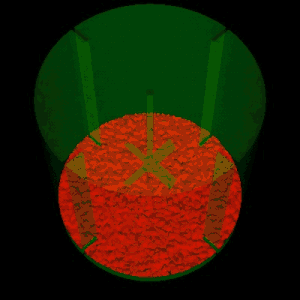 |
|
|
|
|
PBT Mixing LThis CFD represents a mixing time experiment using a 45o pitched bladed turbine (PBT) in low resolution. Note For better image quality have a look at the high resolution version of this CFD. Caution: If you do this using a dial up modem, leave plenty of time for the download. The fluid to mix is spread out upon the base of the tank. Notice that the last zones of mixing are behind the baffles. If you want to see the action again, click on your reload button of your web browser otherwise wait for it to reload automatically. Computational Fluid Dynamics, or in this specific case, computational fluid mixing is a very powerful tool when experimentation is either not possible, dangerous, or too expensive. Ask Post Mixing for a quote on CFD experiments for your process and reactor. We are not limited to mixing tanks. We can also do static mixers and mixing in pipes, etc. and even subjects like mixing honey in your tea. If this is what you are looking for, please fill out the Contact Us form . We will get back to you as soon as possible. |

|
Description of this CFDBasic Summary of the Physical Conditions:
| |
|
|